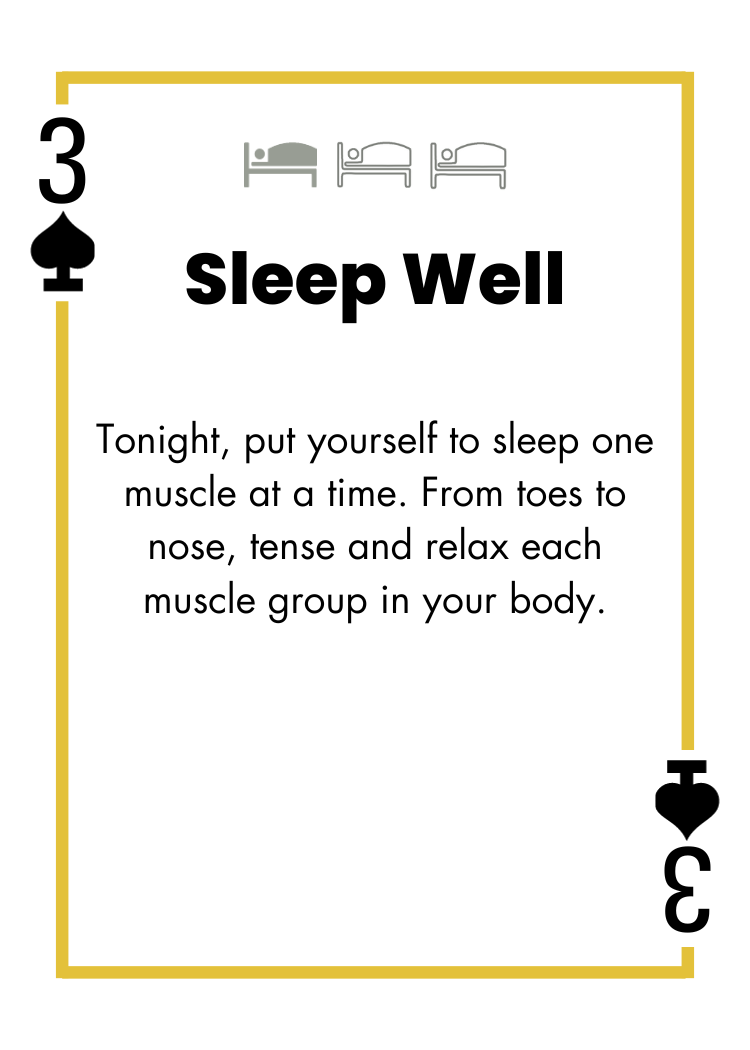3 of Spades - Progressive Muscle Relaxation

Progressive muscle relaxation is a great method of reducing muscle tension. Starting from the toes, notice how that muscle feels when it is tensed. Hold this tension for five seconds while breathing in. Then, release and relax that muscle all at once.
This tip takes a bit of practice so stick with it this week and that 1% improvement is just around the corner.

This exercise is performed by methodically tensing and relaxing different muscle groups, one by one. This technique is adapted and provided from Newsom and Rehman, 2024.
The muscle groups can be categorised as follows: Toes and feet, legs and thighs, hips and buttocks, stomach and back, hands and wrists, and forearms, biceps, shoulders, and chest, front and back of the neck, mouth and cheeks, and jaw, and finally eyes, nose, and forehead.
Once you’re ready, and have the list of muscle groups down, lie down in bed and try the technique:
- Breathe in and tense the first group of muscles for 5-10 seconds.
- Breathe out and quickly relax the muscles in that group.
Stay relaxed for 10-20 seconds before moving to the next muscle group. Continue with each muscle group until all are finished.
Empirical evidence supports the use of progressive muscle relation in high-level stress responses to assist with reduction of tension headaches, and insomnia, as an additional treatment in cancer, chronic pain management in inflammatory arthritis and irritable bowel syndrome (McCallie et al., 2006).
A large amount of evidence also supports the value of progressive muscle relaxation in reducing stress, anxiety, and depression among adults. Moreover, research studies find progressive muscle relaxation when combined with other interventions are more effective compared to when they are applied on their own (Muhammad et al., 2024).
Progressive muscle relaxation has been demonstrated to be beneficial in reducing stress, anxiety, and depression in adults. When progressive muscle relaxation is combined with other interventions, the combined techniques have also consistently exhibited enhanced usefulness, particularly for stress and anxiety. The authors’ systematic review found a total of 24 studies supporting progressive muscle relaxation effectiveness in reducing stress, 21 studies in reducing anxiety, and 11 studies in reducing depression (Muhammad et al., 2024).
A study by Palow and Jones, 2002, illustrates an additional noteworthy concept for the use of progressive muscle relaxation which involves the impact upon salivary cortisol and its immunoenhancement effects. The theory behind the field of immunoenhancement suggests as relaxation occurs this gives positive immune system benefits to an individual. The authors found the results from the salivary cortisol study indicate a behavioural manipulation of the body’s stress hormone, cortisol, is possible. A short relaxation exercise led to experimental participants having significantly lower levels of post-intervention heart rate, state anxiety, perceived stress, and salivary cortisol than control subjects. Increased levels of self-reported levels of relaxation were also noted. Additionally, the results lend support to the theory that the negative effects of stress on the immune system may be reversible.
Small changes CAN make a big difference – that’s what The 1% Club is all about.
Mindful Breathing: Progressive Muscle Relaxation
American Lung Association
https://www.youtube.com/watch?v=utGa6rqzs3g
McCallie, M. S., Blum, C. M., & Hood, C. J. (2006). Progressive muscle relaxation. Journal of human behavior in the social environment, 13(3), 51-66.
Muhammad Khir, S., Wan Mohd Yunus, W. M. A., Mahmud, N., Wang, R., Panatik, S. A., Mohd Sukor, M. S., and Nordin, N. A. (2024). Efficacy of Progressive Muscle Relaxation in Adults for Stress, Anxiety, and Depression: A Systematic Review. Psychology Research and Behavior Management, 345-365.
Newsom, R., and Rehman, A. (2024, February 27). Relaxation exercises to help fall asleep. Sleep Foundation. https://www.sleepfoundation.org/sleep-hygiene/relaxation-exercises-to-help-fall-asleep
Palow, L.A., and Jones, G. E. (2002). The impact of abbreviated progressive muscle re- laxation on salivary cortisol. Biological Psychology, 60, 1-16.


 See Other Cards!
See Other Cards!